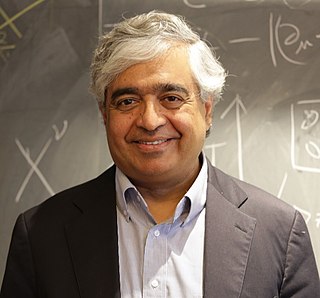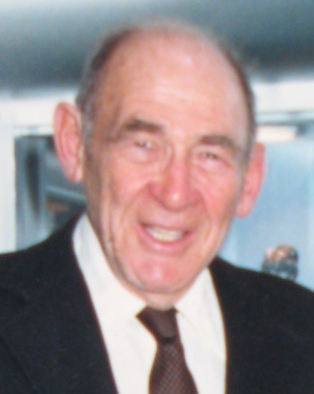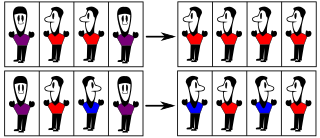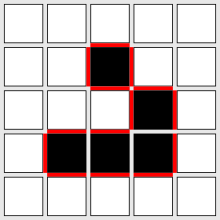Ernst Ising was a German physicist, who is best remembered for the development of the Ising model. He was a professor of physics at Bradley University until his retirement in 1976.
In statistical mechanics, the Potts model, a generalization of the Ising model, is a model of interacting spins on a crystalline lattice. By studying the Potts model, one may gain insight into the behaviour of ferromagnets and certain other phenomena of solid-state physics. The strength of the Potts model is not so much that it models these physical systems well; it is rather that the one-dimensional case is exactly solvable, and that it has a rich mathematical formulation that has been studied extensively.

John Clive Ward, was a Anglo-Australian physicist who made significant contributions to quantum field theory, condensed-matter physics, and statistical mechanics. Andrei Sakharov called Ward one of the titans of quantum electrodynamics.
The Kramers–Wannier duality is a symmetry in statistical physics. It relates the free energy of a two-dimensional square-lattice Ising model at a low temperature to that of another Ising model at a high temperature. It was discovered by Hendrik Kramers and Gregory Wannier in 1941. With the aid of this duality Kramers and Wannier found the exact location of the critical point for the Ising model on the square lattice.

A spin ice is a magnetic substance that does not have a single minimal-energy state. It has magnetic moments (i.e. "spin") as elementary degrees of freedom which are subject to frustrated interactions. By their nature, these interactions prevent the moments from exhibiting a periodic pattern in their orientation down to a temperature much below the energy scale set by the said interactions. Spin ices show low-temperature properties, residual entropy in particular, closely related to those of common crystalline water ice. The most prominent compounds with such properties are dysprosium titanate (Dy2Ti2O7) and holmium titanate (Ho2Ti2O7). The orientation of the magnetic moments in spin ice resembles the positional organization of hydrogen atoms (more accurately, ionized hydrogen, or protons) in conventional water ice (see figure 1).
Igor R. Klebanov is an American theoretical physicist. Since 1989, he has been a faculty member at Princeton University where he is currently a Eugene Higgins Professor of Physics and the Director of the Princeton Center for Theoretical Science. In 2016, he was elected to the National Academy of Sciences. Since 2022, he is the Director of the Simons Collaboration on Confinement and QCD Strings.
Quantum annealing (QA) is an optimization process for finding the global minimum of a given objective function over a given set of candidate solutions, by a process using quantum fluctuations. Quantum annealing is used mainly for problems where the search space is discrete with many local minima; such as finding the ground state of a spin glass or the traveling salesman problem. The term "quantum annealing" was first proposed in 1988 by B. Apolloni, N. Cesa Bianchi and D. De Falco as a quantum-inspired classical algorithm. It was formulated in its present form by T. Kadowaki and H. Nishimori in "Quantum annealing in the transverse Ising model" though an imaginary-time variant without quantum coherence had been discussed by A. B. Finnila, M. A. Gomez, C. Sebenik and J. D. Doll, in "Quantum annealing is a new method for minimizing multidimensional functions".

The Feynman checkerboard, or relativistic chessboard model, was Richard Feynman’s sum-over-paths formulation of the kernel for a free spin-½ particle moving in one spatial dimension. It provides a representation of solutions of the Dirac equation in (1+1)-dimensional spacetime as discrete sums.

Bruria Kaufman was an American theoretical physicist. She contributed to Albert Einstein's general theory of relativity, to statistical physics, where she used applied spinor analysis to rederive the result of Lars Onsager on the partition function of the two-dimensional Ising model, and to the study of the Mössbauer effect, on which she collaborated with John von Neumann and Harry Lipkin.

Subir Sachdev is Herchel Smith Professor of Physics at Harvard University specializing in condensed matter. He was elected to the U.S. National Academy of Sciences in 2014, and received the Lars Onsager Prize from the American Physical Society and the Dirac Medal from the ICTP in 2018. He was a co-editor of the Annual Review of Condensed Matter Physics from 2017-2019.

Arthur S. Iberall was an American physicist/hydrodynamicist and engineer who pioneered homeokinetics, the physics of complex, self-organizing systems. He was the originator of the concept of lines of non-extension on the human body which was used to create workable space suits.

Piers Coleman is a British-born theoretical physicist, working in the field of theoretical condensed matter physics. Coleman is Professor of Physics at Rutgers University in New Jersey and at Royal Holloway, University of London.

Quantum simulators permit the study of a quantum system in a programmable fashion. In this instance, simulators are special purpose devices designed to provide insight about specific physics problems. Quantum simulators may be contrasted with generally programmable "digital" quantum computers, which would be capable of solving a wider class of quantum problems.

The Sznajd model or United we stand, divided we fall (USDF) model is a sociophysics model introduced in 2000 to gain fundamental understanding about opinion dynamics. The Sznajd model implements a phenomenon called social validation and thus extends the Ising spin model. In simple words, the model states:
Raymond Ethan Goldstein FRS FInstP is Schlumberger Professor of Complex Physical Systems in the Department of Applied Mathematics and Theoretical Physics (DAMTP) at the University of Cambridge and a Fellow of Churchill College, Cambridge.
Arthur Brooks Harris, called Brooks Harris, is an American physicist.
In statistical mechanics, probability theory, graph theory, etc. the random cluster model is a random graph that generalizes and unifies the Ising model, Potts model, and percolation model. It is used to study random combinatorial structures, electrical networks, etc. It is also referred to as the RC model or sometimes the FK representation after its founders Cees Fortuin and Piet Kasteleyn.
Schelling's model of segregation is an agent-based model developed by economist Thomas Schelling. Schelling's model does not include outside factors that place pressure on agents to segregate such as Jim Crow laws in the United States, but Schelling's work does demonstrate that having people with "mild" in-group preference towards their own group could still lead to a highly segregated society via de facto segregation.
Replica cluster move in condensed matter physics refers to a family of non-local cluster algorithms used to simulate spin glasses. It is an extension of the Swendsen-Wang algorithm in that it generates non-trivial spin clusters informed by the interaction states on two replicas instead of just one. It is different from the replica exchange method, as it performs a non-local update on a fraction of the sites between the two replicas at the same temperature, while parallel tempering directly exchanges all the spins between two replicas at different temperature. However, the two are often used alongside to achieve state-of-the-art efficiency in simulating spin-glass models.










